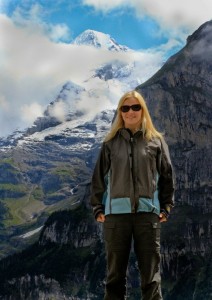Our latest 10 Minute Interview is with Jennifer Clear, a fellow PhD student here in the School of Environmental Sciences, University of Liverpool. She is approaching her submission deadline and will soon be leaving to take up a PostDoc position in Prague, Czech Republic. We will be sad to see her go! Jen has kindly helped on a number of my fieldwork expeditions as well as teaching me how to spot (a few) pollen grains and charcoal fragments in my sediment samples.
Her paper ‘Holocene fire frequency variability in Vesijako, Strict Nature Reserve, Finland, and its application to conservation and management’ has recently been published in the journal Biological Conservation and is available here (Open Access!!). (Note to self – I like the graphical abstract idea too, must look into this option further).
Vital Statistics
- You are: Jennifer Clear (jenclear@liv.ac.uk)
- You work at: University of Liverpool
- Your role is: PhD student
Q1) What are you currently working on?
Holocene forest fire disturbance and vegetation dynamics in small forest hollow environments in Finland
Q2) Could you provide a brief insight into the main findings of your recent paper in Biological Conservation?
Fire was much less frequent in the forest in Vesijako, Finland prior to intensive anthropogenic disturbance and this human induced increase in fire frequency coincides with a decline in floristic diversity. The dominance of Picea abies(Norway spruce) could be responsible for the current lack of fire and if this remains the case then we could expect much lower frequency, higher intensity fires in the future.
Q3) As an Early Career Researcher, what has been the highlight of your career so far?
There are many milestones to reach as a postgraduate researcher and my most recent highlight has to be my first publication. However, before the end of the year I have a new milestone to reach and hopefully my new highlight will be being awarded my PhD.
Q4) What is a typical day like for you?
I usually arrive in the office and check emails (and the news) before spending time in the lab or looking down a microscope counting pollen. Data analysis is always ongoing but at this stage of my PhD a lot of time is spent writing. There is always something on the side to arrange whether it be a conference to attend or help organise or fieldwork logistics to sort out. Getting out of the office to have coffee and lunch is an important part of the day as it is a chance to discuss and gain insightful opinions on work progress with other students and academics.
Q5) To what locations has your research taken you and why?
Through projects FIREMAN, PRIFOR and LANDCLIM I am grateful to have had the opportunity to attend many small research conferences and field excursions that enabled me to meet and chat with other like minded students and academics. As a boreal palaeoecologist I have been lucky to undertake fieldwork in some amazing places: I have crossed the Arctic Circle in Norway, Sweden and Finland; glimpsed the northern lights in Lappi, Finland; snowshoed through forest to core lakes through the ice (with a spot of ice fishing) in Canada; experienced the mid-night sun while coring lakes from a raft in Sweden; and not to forget, visited many mosquito infested forest hollows, often with a campfire and sauna waiting in the evening.
Q6) Do you have one piece of advice for new Postgraduates?
As an incentive to continue onto postgraduate research the opportunities to travel and meet new and likeminded people are amazing but don’t be afraid to go and speak to the professor you referenced several times in your last dissertation – remember he was once where you are now. Day to day this is not a normal 9-5 job, having that ‘Friday feeling’ on a Monday morning not knowing what your next set of results is going to show is motivation enough to keep going.
Q7) If you could invent an element, what would it be called and what would it do?
Hindsight (Hi) – a Noble gas that enables a chemical reaction to take place in the brain that links cause and effect. It may help with some current environmental issues.
JENNIFER CLEAR is a physical geographer and palaeoecologist with an interest in long-term forest dynamics and environmental change. Her PhD research focused on fire frequency disturbance in Scandinavia and she will soon expand her research area into central European mountain environments. Jen loves visiting new places and is at her happiest outdoors – regardless of the weather.

